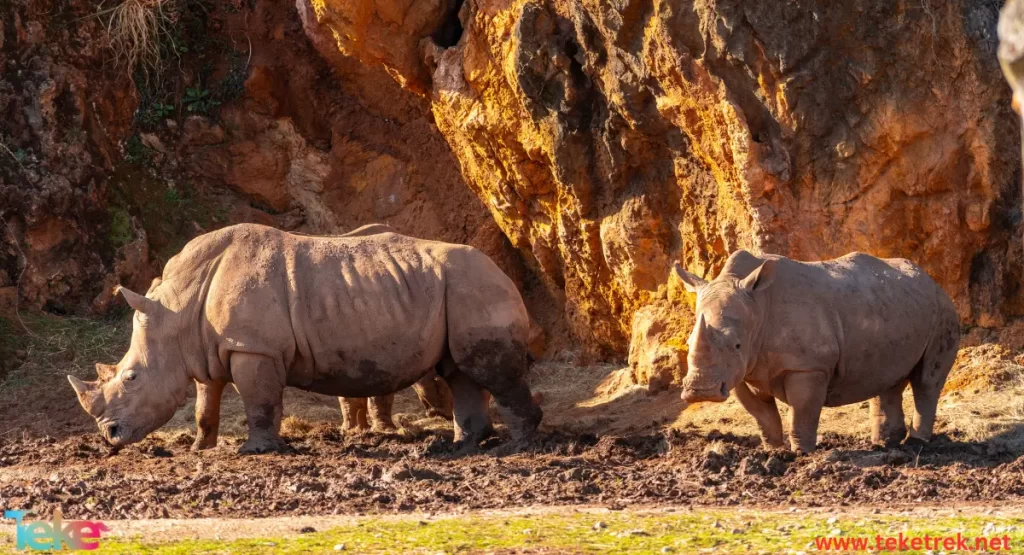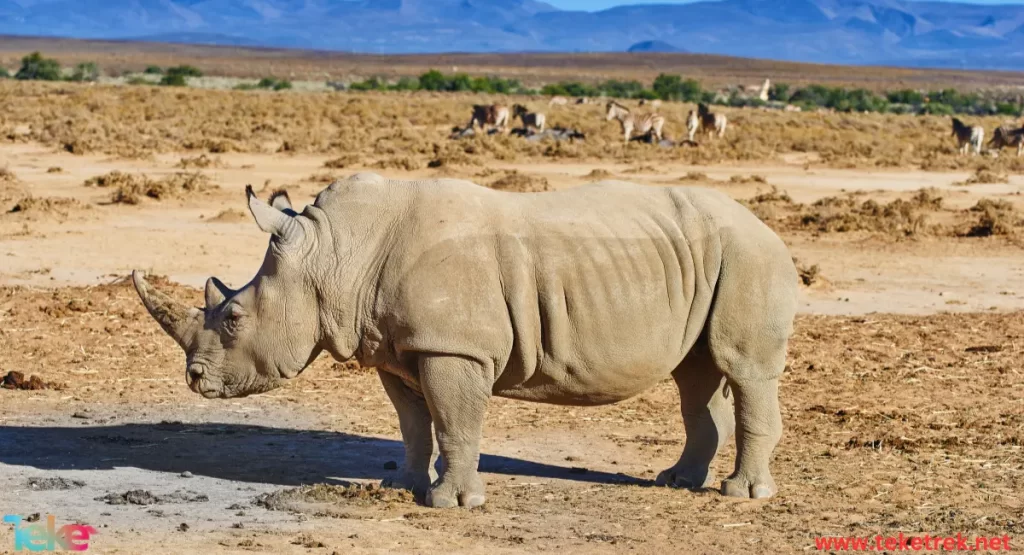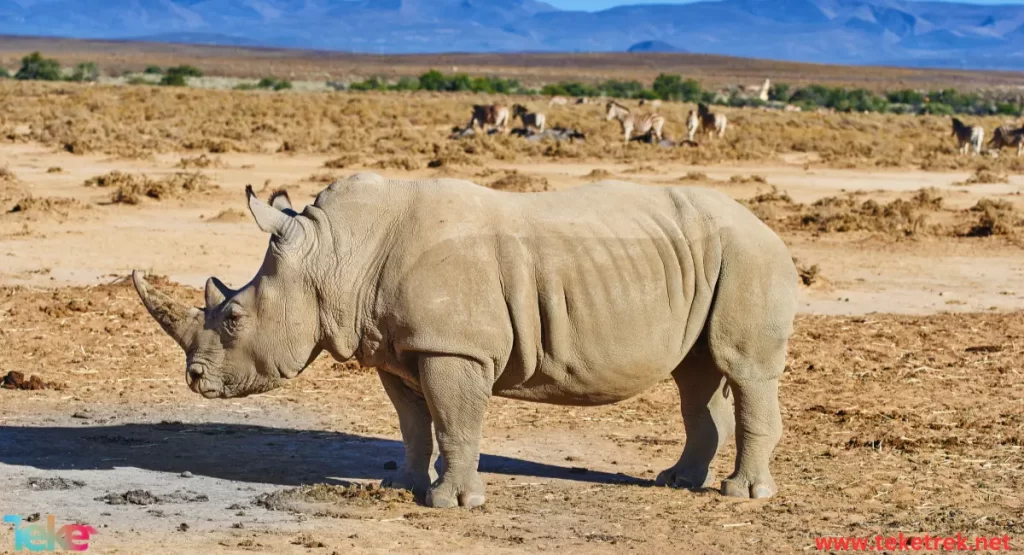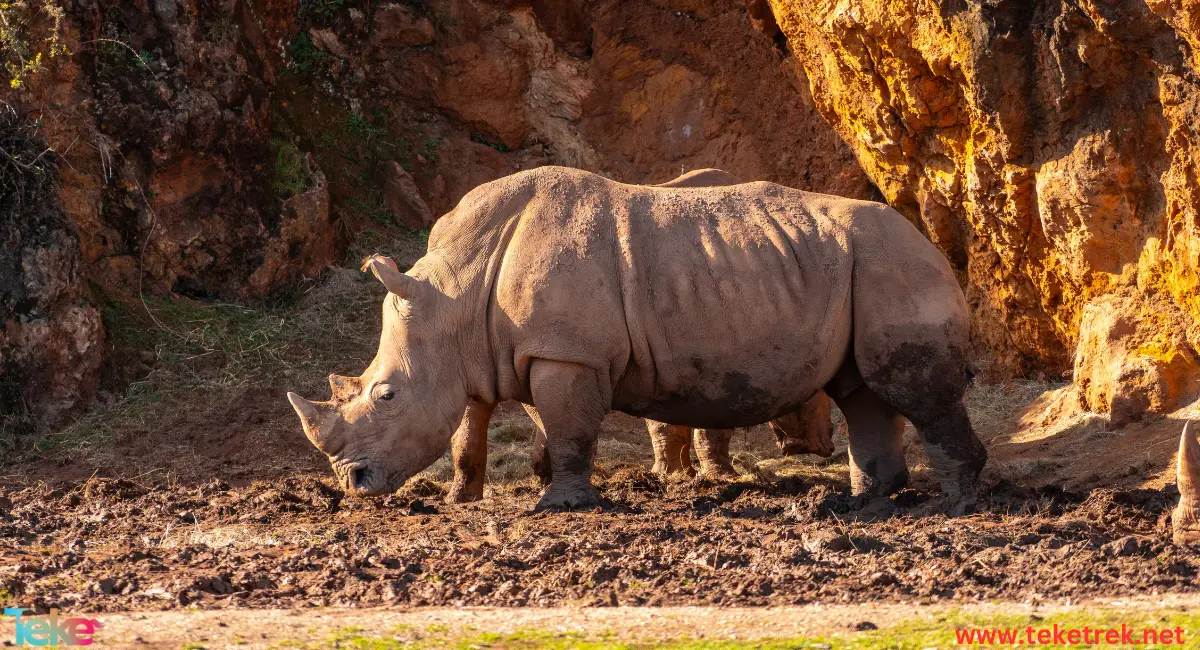The White rhinoceros is one of the most famous and largest wild animal in Africa. It is considered a threatened mammal, distinguished by its massive body, substantial size, and the presence of distinctive tusks atop its head. Its scientific name is: Ceratotherium simum.
Specifications of the white rhinoceros horn
- It possesses a large and robust body with strong, thick limbs, a short neck, and a broad chest. It has a noticeable mass on the back of its neck.
- The male’s length reaches approximately 4 meters, while females range between 3.35 to 3.65 meters. The male weighs an average of 2000-2300 kilograms, while the female’s weight averages 1600-1700 kilograms.
- It has a large and arched head with a powerful jaw, featuring a wide straight mouth used for grazing. It has a massive neck supporting heavy horns and a short, thick tail with four toes on each foot.
- Its skin is usually gray or brown, with colors varying according to the seasons.
- It has the widest nostril openings among wild animals, heavily relying on its sense of smell, with nasal passages larger than its entire brain.
- It features two large horns on the skull, with the front horn growing larger than the rear one. Males typically average 60 cm in length, while females can have horns reaching up to 166 cm. These horns, made of keratin, serve purposes in self-defense and competition with females.
- It has two large ears capable of independent movement for sound detection, relatively small eyes compared to its large size, and weak eyesight.
- The white rhinoceros possesses strong physical abilities and can reach speeds of up to 50 km/h in running.
- It is usually calm and peaceful but is powerful and exhibits aggression when defending itself.
- It can live up to 50 years in the wild.
- It is used in safaris and tourist expeditions as a symbol of African wilderness.

Origin and lineage of the white rhinoceros
- It inhabits South and East Africa, with a presence in countries such as South Sudan, Namibia, Zimbabwe, South Africa, Botswana, Mozambique, and Tanzania.
- It usually inhabits grasslands and savannas and tends to favor areas where flowing water and marshes are present.
- The origin of the white rhinoceros dates back to the African continent, where these animals were once widespread in diverse prairie regions. However, due to illegal hunting and habitat loss, these animals have become endangered and are now found in specific regions within the national borders of some African countries.
The reason behind the name white rhino
It was named as a result of a translation misunderstanding from Afrikaans to English. Initially, it was called “wijde” or “wide” in Afrikaans, meaning “wide,” referring to its wide mouth rather than the color of its skin, which could be light.
A translation error occurred when converting this name into English, using “white” instead of “wide.” Hence, the English name “white rhinoceros” originated. Although this type of white rhinoceros is not always white in color, the English name continued to be used.
These animals are called “rhinoceros” due to the distinctive horns growing on their heads. It is believed that these horns are the reason for their name, as this part of their body is the most distinctive and attention-grabbing feature. Despite being referred to as horns, they are actually made of a material similar to nails called keratin, not real bones.
White rhino food
- It is herbivorous, primarily feeding on grasses and herbs found in meadows and plains. Its daily diet may include various types of grass, such as tall grass and diverse herbs that grow in its habitat.
- It drinks water twice a day if available, and it can survive several days without water in dry conditions.
- Typically, it consumes large amounts of grass, up to 50 kilograms of food daily.
- It spends half of the day eating, one-third in rest, and the rest of the day engaged in various activities. It enjoys lying in the mud for cooling, believed to have an impact on the savanna environment and ecosystem. Its destruction could negatively affect the environment and other animals.
- Relying on this plant-based diet is crucial for maintaining its strength and daily activities in the prairies and plains where it resides.
White rhinoceros reproduction
White rhinoceros is mammals animal:
- Females reach sexual maturity at the age of 6-7 years, while males reach sexual maturity between the ages of 10-12 years.
- The gestation period lasts for about 16 months, and females usually give birth to one calf at a time.
- The newborn calf weighs between 40 to 65 kilograms.
- The mother takes great care of her calf, providing care during the nursing period and ensuring constant protection.
- Maternal care is crucial for the white rhinoceros, as mothers continue to provide care and nourishment for their offspring for an extended period after birth.


The difference between male and female white rhinos
1- Typically, males are larger in size and heavier than females.
2- Female horns are generally longer than those of males.
3- Males may exhibit more aggressive or competitive behavior in some cases, especially during mating periods and competition for females.
4- Males seem to reach sexual maturity at a slower rate compared to females.
Is the white rhinoceros classified as endangered?
There are two types of white rhinoceros:
1. The Southern white rhinoceros is the type with a more widespread distribution.
2. The Northern white rhinoceros is considered critically endangered, and it is believed to be possibly extinct in the wild.
Conservation and breeding efforts for the Northern white rhinoceros aim to save it from potential extinction by preserving the remaining animals, attempting reproduction, conserving genetic diversity, and conducting scientific research.
FAQ
- How many white rhinos are left?
The number of white rhinos is about 10,080 individuals.
- How did the white rhino go extinct?
The rhino became extinct as a result of poaching and civil war in the areas where it lives.
- Why is white rhino called white?
The rhinoceros is named because it has a muzzle in the front.
- What does the white rhino eat?
Rhinoceros is a herbivorous animal
It feeds on small shrubs, their leaves, fruits, twigs and buds.
And finally
Poachers continue their illegal hunting of white rhinos, despite intensified efforts to combat poaching in many African countries. Poachers can reap substantial profits from their horns, reaching tens of thousands of dollars per kilogram in the black market in Asia. This encourages them to take the risk of imprisonment or even death.







Your point of view caught my eye and was very interesting. Thanks. I have a question for you.
Thanks